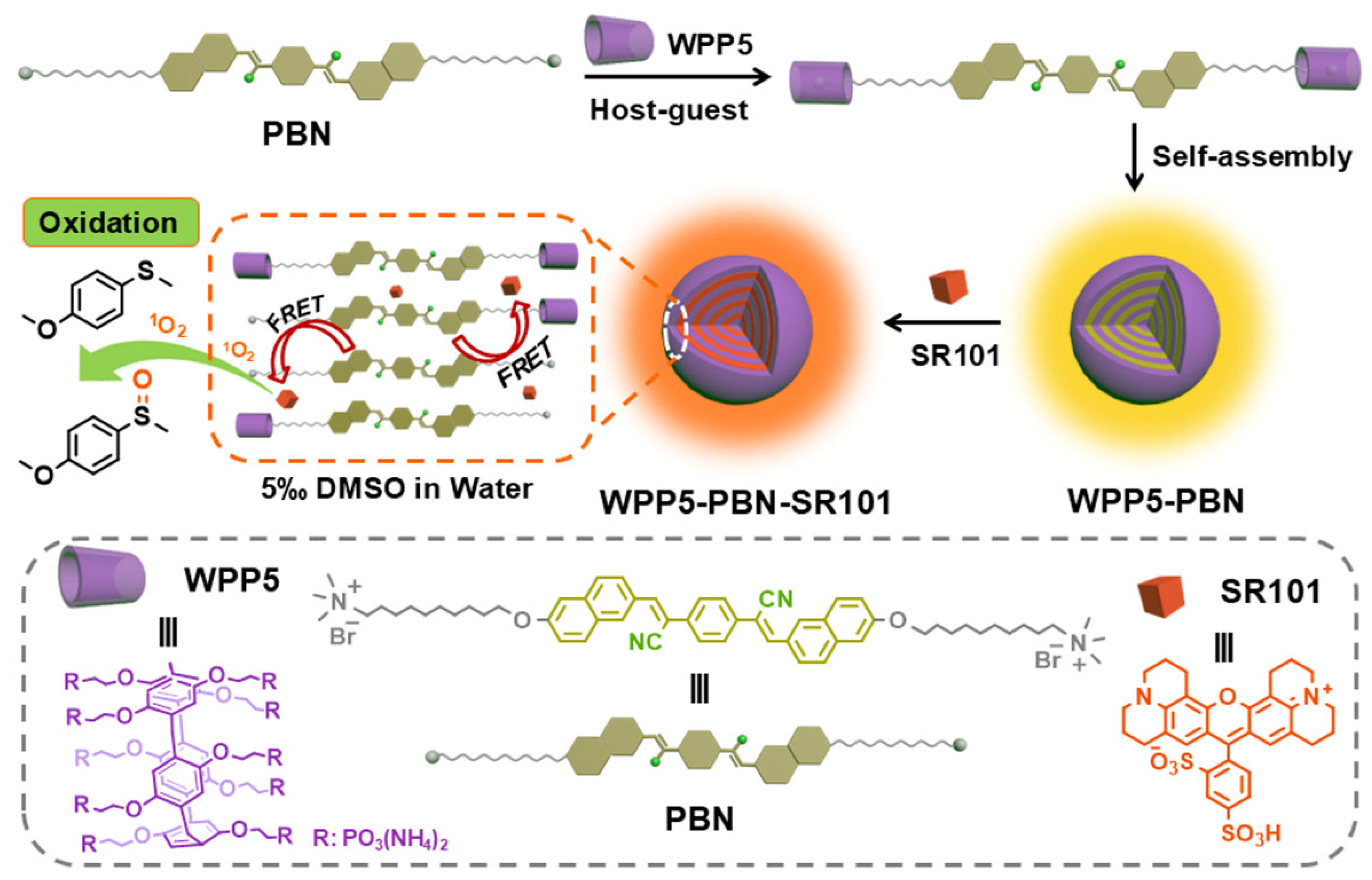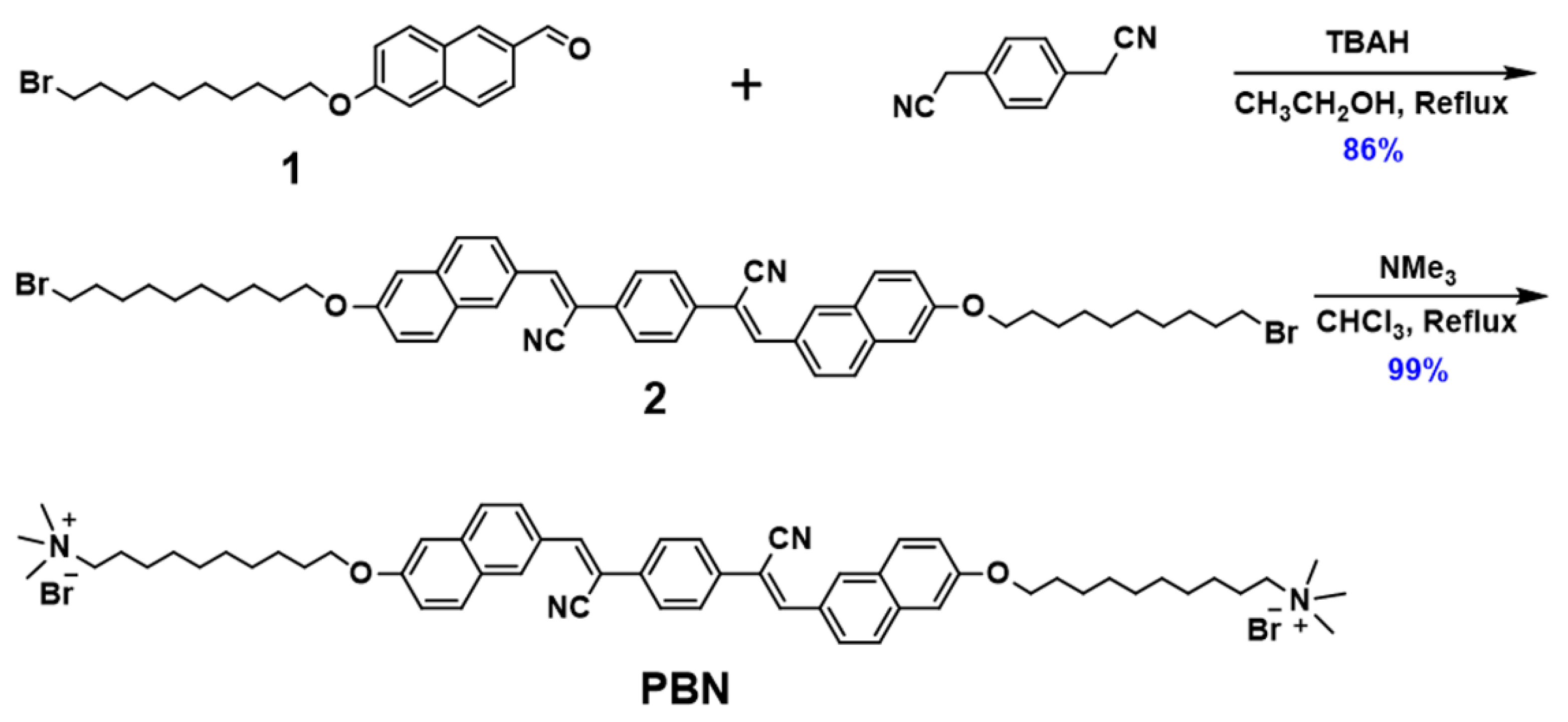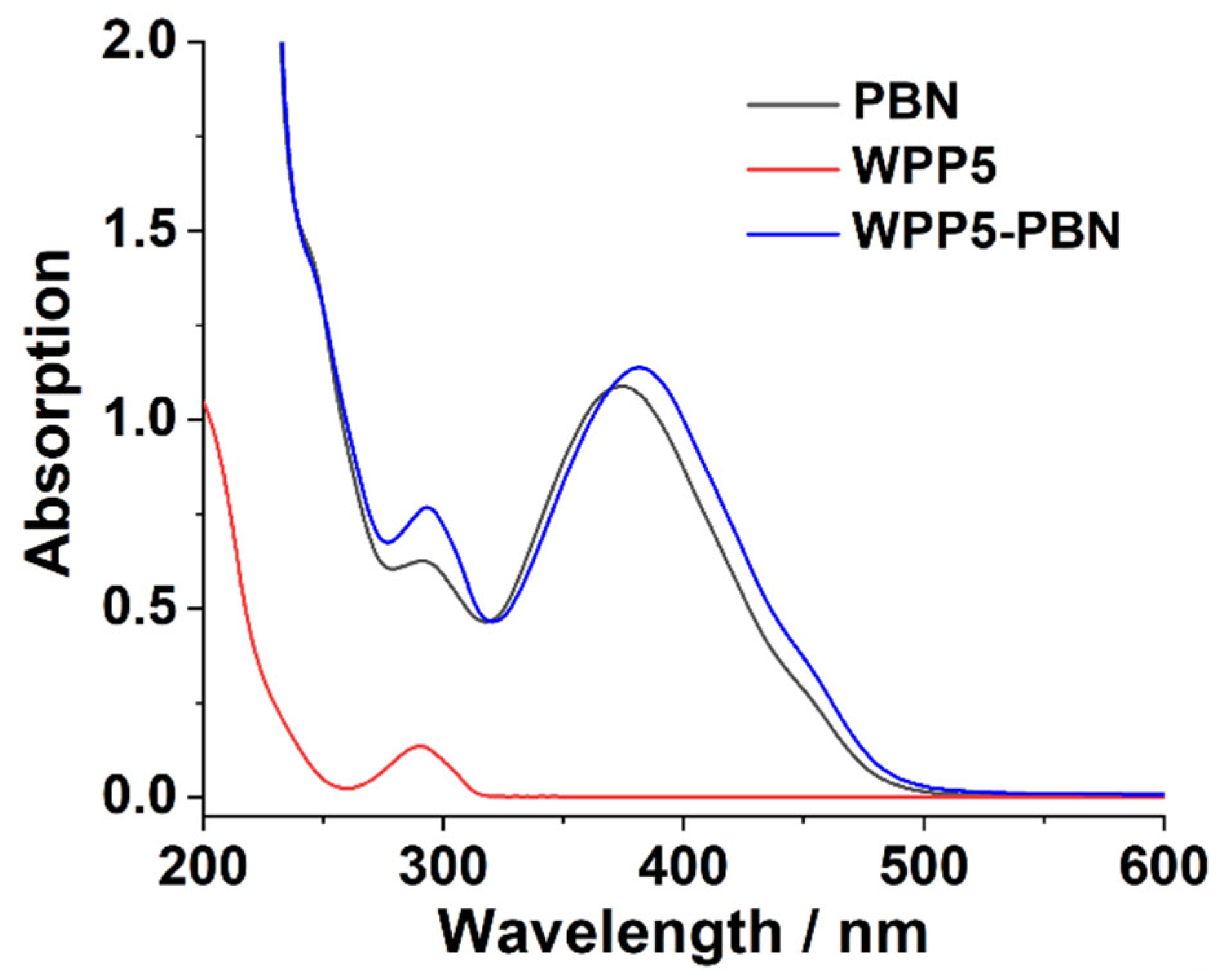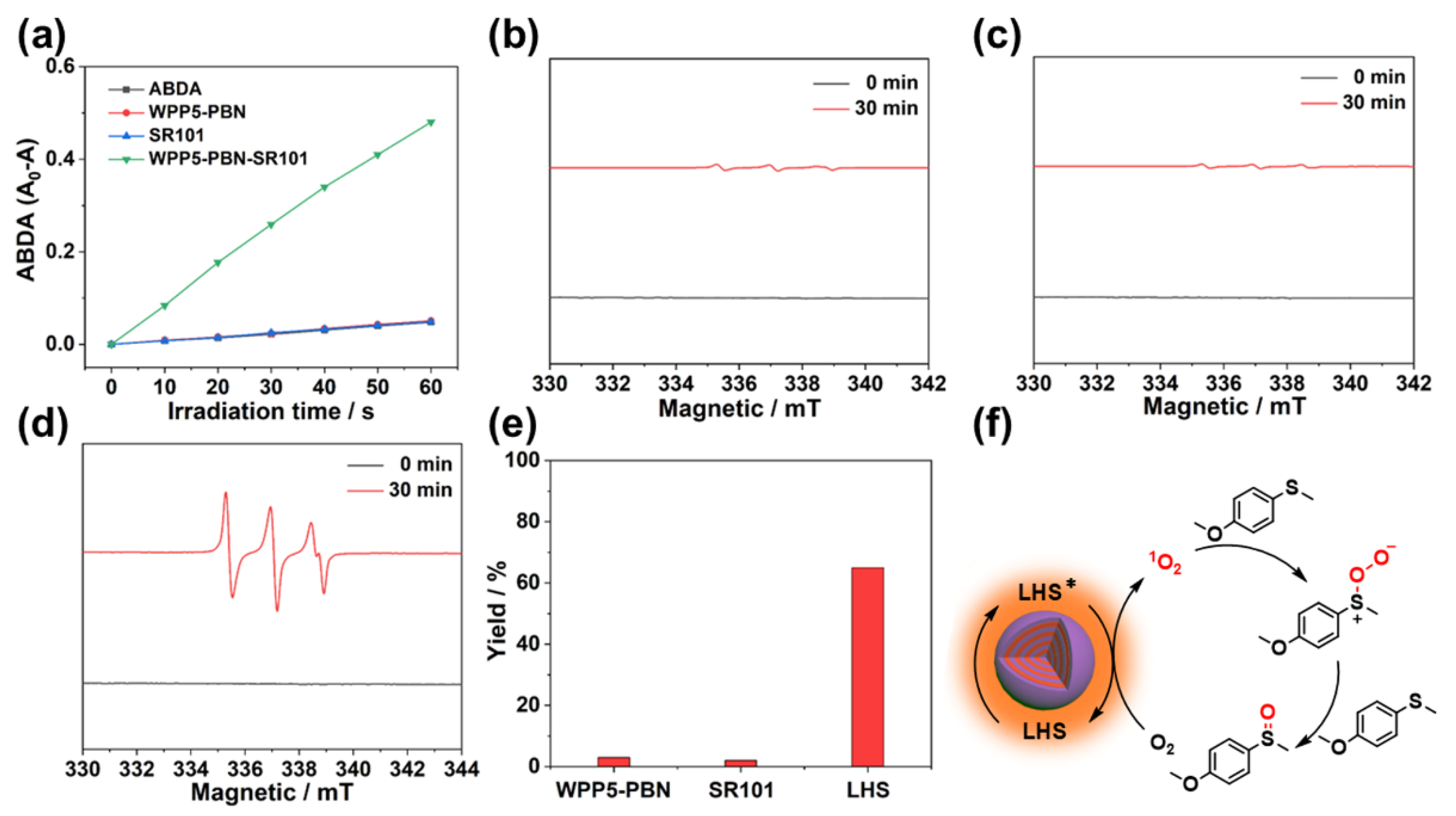Phenyl-Bis-Naphthyl Derivative-Based Artificial Light-Harvesting System for Singlet Oxygen Oxidation
Abstract
1. Introduction
2. Results and Discussion
2.1. Construction of Supramolecular Nanoparticles
2.2. Investigation of Energy Transfer Process
2.3. Investigation of Photooxidation Reaction
3. Materials and Methods
3.1. Synthesis of PBN
3.2. Construction of Supramolecular Nanoparticles
3.3. Photooxidation of 4-Methoxythioanisole
4. Conclusions
Supplementary Materials
Author Contributions
Funding
Institutional Review Board Statement
Informed Consent Statement
Data Availability Statement
Conflicts of Interest
References
- Croce, R.; Amerongen, H.V. Light harvesting in oxygenic photosynthesis: Structural biology meets spectroscopy. Science 2020, 369, eaay2058. [Google Scholar] [CrossRef]
- Wei, X.; Su, X.; Cao, P.; Liu, X.; Chang, W.; Li, M.; Zhang, X.; Liu, Z. Structure of spinach photosystem II–LHCII supercomplex at 3.2 Å resolution. Nature 2016, 534, 69–74. [Google Scholar] [CrossRef]
- Zhang, R.; Tian, X.; Zuo, M.; Zhang, T.; Pangannaya, S.; Hu, X.-Y. Bionic artificial leaves based on AIE-active supramolecular hydrogel for efficient photocatalysis. Adv. Sci. 2025, 12, 2504993. [Google Scholar] [CrossRef]
- Sun, G.; Li, M.; Li, J.; Feng, J.; Yan, Z.; Sun, Y.; Pu, L.; Zhu, J.; Tang, Y.; Yao, Y. Enhanced emission in a supramolecular artificial light-harvesting system for a photocatalytic thiol-ene reaction. Chem. Commun. 2025, 61, 6360–6363. [Google Scholar] [CrossRef]
- Duan, Q.; Zhang, Q.; Zhang, J.; Lin, S.; Xiao, T.; Wang, L. Artificial light-harvesting systems based on supramolecular polymers. Chin. Chem. Lett. 2025, 36, 111421. [Google Scholar] [CrossRef]
- Xu, W.-W.; Qin, Y.-X.; Yu, X.-Y.; Jiang, L.-N.; Zhang, H.-Y.; Chen, Y.; Liu, Y. Multipath cascade light harvesting for multicolor luminescence based on macrocyclic sulfonatocalix[4]arene. Chin. Chem. Lett. 2025, 36, 111068. [Google Scholar] [CrossRef]
- Zhang, L.; Qian, H.; Wu, Z.; Zhang, Q.; Li, S.; Cheng, M.; Xiao, T. Non-covalent dimer as donor chromophore for constructing artificial light-harvesting system in water. Molecules 2022, 27, 8876. [Google Scholar] [CrossRef]
- Sun, G.; Li, M.; Cai, L.; Zhu, J.; Tang, Y.; Yao, Y. Carbazole-based artificial light-harvesting system for photocatalytic cross-coupling dehydrogenation reaction. Chem. Commun. 2024, 60, 1412–1415. [Google Scholar] [CrossRef]
- Liu, M.-X.; Su, X.-L.; Chen, P.; Liu, Y.-Y.; Li, J.-P.; Zou, L.; Tang, B.Z.; Feng, H.-T. Sequential FRET system based on macrocyclic AIEgens for versatile photocatalysis. Chin. Chem. Lett. 2025, 111516. [Google Scholar] [CrossRef]
- Luo, J.; Xie, Z.; Lam, J.W.Y.; Cheng, L.; Chen, H.; Qiu, C.; Kwok, H.S.; Zhan, X.; Liu, Y.; Zhu, D.; et al. Aggregation-induced emission of 1-methyl-1,2,3,4,5-pentaphenylsilole. Chem. Commun. 2001, 18, 1740. [Google Scholar] [CrossRef] [PubMed]
- Wang, K.; Velmurugan, K.; Li, B.; Hu, X.Y. Artificial light-harvesting systems based on macrocycle-assisted supramolecular assembly in aqueous media. Chem. Commun. 2021, 57, 13641–13654. [Google Scholar] [CrossRef]
- Wu, Z.; Qian, H.; Li, X.; Xiao, T.; Wang, L. Recent advances in two-step energy transfer light-harvesting systems driven by non-covalent self-assembly. Chin. Chem. Lett. 2024, 35, 108829. [Google Scholar] [CrossRef]
- Wang, K.; Zhang, R.; Song, Z.; Zhang, K.; Tian, X.; Pangannaya, S.; Zuo, M.; Hu, X.-Y. Dimeric pillar[5]arene as a novel fluorescent host for controllable fabrication of supramolecular assemblies and their photocatalytic applications. Adv. Sci. 2023, 10, 2206897. [Google Scholar] [CrossRef]
- Zhang, D.; Yu, W.; Li, S.; Xia, Y.; Li, X.; Li, Y.; Yi, T. Artificial light-harvesting metallacycle system with sequential energy transfer for photochemical catalysis. J. Am. Chem. Soc. 2021, 143, 1313–1317. [Google Scholar] [CrossRef] [PubMed]
- Yang, X.-Z.; Zhang, Z.-G.; Xin, C.-L.; Liu, H.; Yu, S.; Xing, L.-B. Artificial light-harvesting system with sequential energy transfer in photocatalytic C-P coupling based on supramolecular organic framework of triphenylamine. J. Colloid Interface Sci. 2025, 680, 587–595. [Google Scholar] [CrossRef] [PubMed]
- Sun, G.; Li, M.; Cai, L.; Wang, D.; Cui, Y.; Hu, Y.; Sun, T.; Zhu, J.; Tang, Y. Water-soluble phosphate-pillar[5]arene (WPP5)-based artificial light-harvesting system for photocatalytic cross-coupling dehydrogenation. J. Colloid Interface Sci. 2023, 641, 803–811. [Google Scholar] [CrossRef]
- Hu, X.-Y.; Liu, X.; Zhang, W.; Qin, S.; Yao, C.; Li, Y.; Cao, D.; Peng, L.; Wang, L. Controllable construction of biocompatible supramolecular micelles and vesicles by water-soluble phosphate pillar[5,6]arenes for selective anti-cancer drug delivery. Chem. Mater. 2016, 28, 3778–3788. [Google Scholar] [CrossRef]
- Yang, Z.; Fu, K.; Yu, W.; Jia, A.; Chen, X.; Cai, Y.; Li, X.; Feng, W.; Yuan, L. A multi-stimuli responsive [3]rotaxane based on hydrogen-bonded aramide azo-macrocycles. Chin. Chem. Lett. 2025, 36, 110842. [Google Scholar] [CrossRef]
- Sun, G.; Hu, M.; Cao, X.; Wan, Z.; Shao, T.; Shen, Y.; Li, M.; Zhu, J.; Tang, Y. Triphenylamine-based artificial light-harvesting system for singlet oxygen production and photooxidation reaction. Mater. Today Chem. 2025, 50, 103185. [Google Scholar] [CrossRef]
- Qian, W.; Zuo, M.; Sun, G.; Chen, Y.; Han, T.; Hu, X.-Y.; Wang, R.; Wang, L. The construction of an AIE-based controllable singlet oxygen generation system directed by a supramolecular strategy. Chem. Commun. 2020, 56, 7301–7304. [Google Scholar] [CrossRef]
- Zhang, R.-Z.; Bi, Y.-S.; Niu, K.-K.; Yu, S.; Liu, H.; Xing, L.-B. Multilevel supramolecular assembly with three-step sequential energy transfer for selective generation of sulfides and sulfoxides by photoredox thiol-ene cross-coupling reactions. Adv. Opt. Mater. 2025, 13, 2402112. [Google Scholar] [CrossRef]
- Zhang, R.-Z.; Liu, H.; Xin, C.-L.; Han, N.; Ma, C.-Q.; Yu, S.; Wang, Y.-B.; Xing, L.-B. Construction of aggregation-induced emission photosensitizers through host-guest interactions for photooxidation reaction and light-harvesting. J. Colloid Interface Sci. 2023, 651, 894–901. [Google Scholar] [CrossRef] [PubMed]
- Sun, G.; Cai, L.; Cui, H.; Hu, Y.; Wang, J.; Wang, M.; Zhu, J.; Sun, T.; Tang, Y. Naphthalenyl-phenylacrylonitrile-based supramolecular aqueous artificial light-harvesting system for photochemical catalysis. Dye. Pigment. 2022, 201, 110257. [Google Scholar] [CrossRef]
- Li, X.-L.; Cheng, D.-L.; Niu, K.-K.; Liu, H.; Yu, S.-S.; Wang, Y.-B.; Xing, L.-B. Construction of supramolecular dimer photosensitizers based on triphenylamine derivatives and cucurbit[8]uril for photocatalysis. J. Mater. Chem. A 2023, 11, 24911–24917. [Google Scholar] [CrossRef]






Disclaimer/Publisher’s Note: The statements, opinions and data contained in all publications are solely those of the individual author(s) and contributor(s) and not of MDPI and/or the editor(s). MDPI and/or the editor(s) disclaim responsibility for any injury to people or property resulting from any ideas, methods, instructions or products referred to in the content. |
© 2025 by the authors. Licensee MDPI, Basel, Switzerland. This article is an open access article distributed under the terms and conditions of the Creative Commons Attribution (CC BY) license (https://creativecommons.org/licenses/by/4.0/).
Share and Cite
Pu, L.; Chen, Y.; Sun, G. Phenyl-Bis-Naphthyl Derivative-Based Artificial Light-Harvesting System for Singlet Oxygen Oxidation. Molecules 2025, 30, 4424. https://doi.org/10.3390/molecules30224424
Pu L, Chen Y, Sun G. Phenyl-Bis-Naphthyl Derivative-Based Artificial Light-Harvesting System for Singlet Oxygen Oxidation. Molecules. 2025; 30(22):4424. https://doi.org/10.3390/molecules30224424
Chicago/Turabian StylePu, Liangtao, Yonglei Chen, and Guangping Sun. 2025. "Phenyl-Bis-Naphthyl Derivative-Based Artificial Light-Harvesting System for Singlet Oxygen Oxidation" Molecules 30, no. 22: 4424. https://doi.org/10.3390/molecules30224424
APA StylePu, L., Chen, Y., & Sun, G. (2025). Phenyl-Bis-Naphthyl Derivative-Based Artificial Light-Harvesting System for Singlet Oxygen Oxidation. Molecules, 30(22), 4424. https://doi.org/10.3390/molecules30224424





